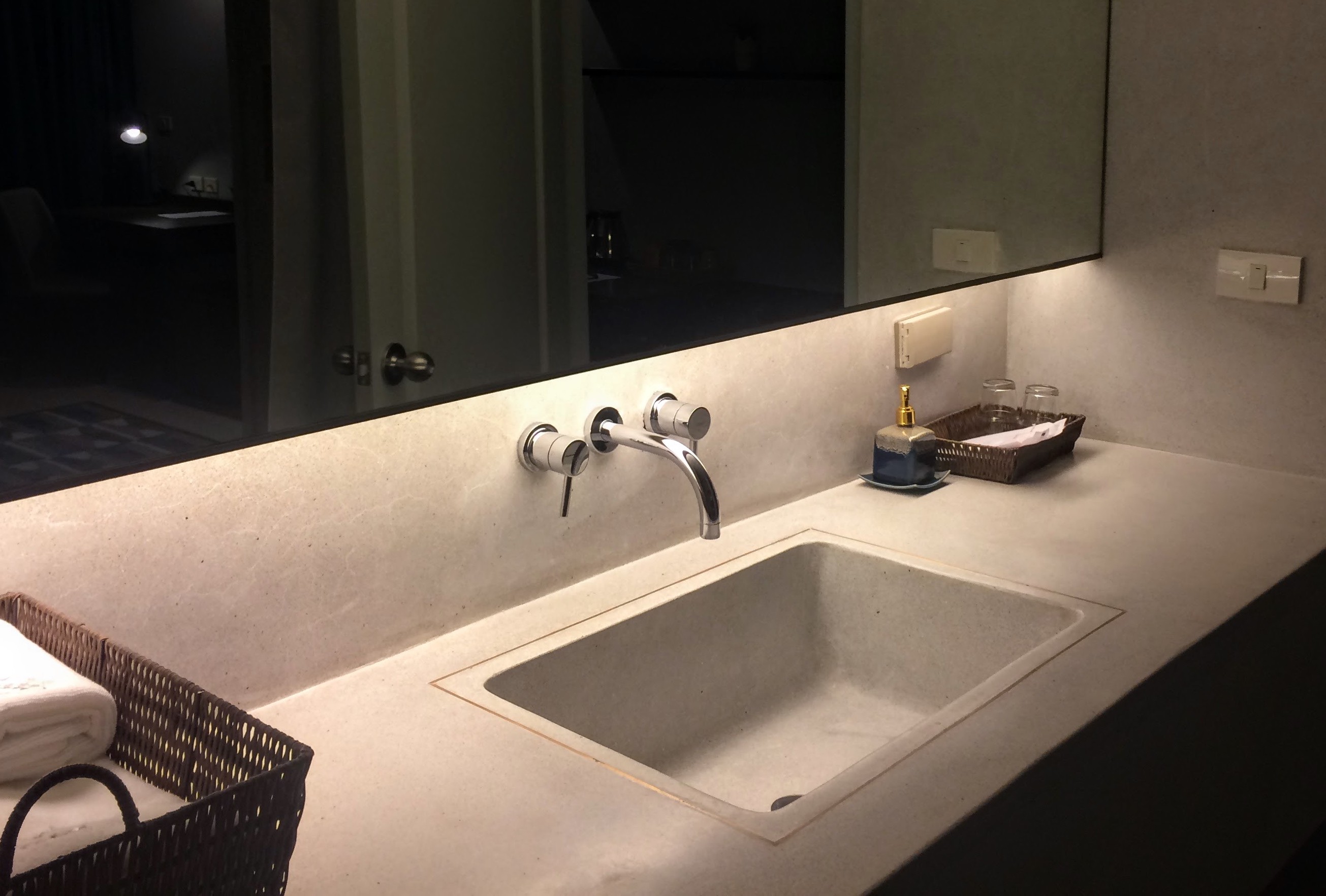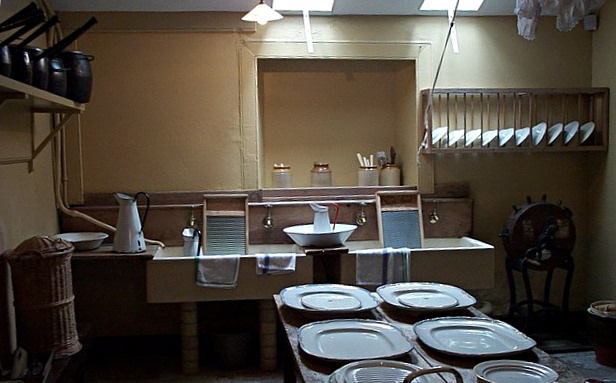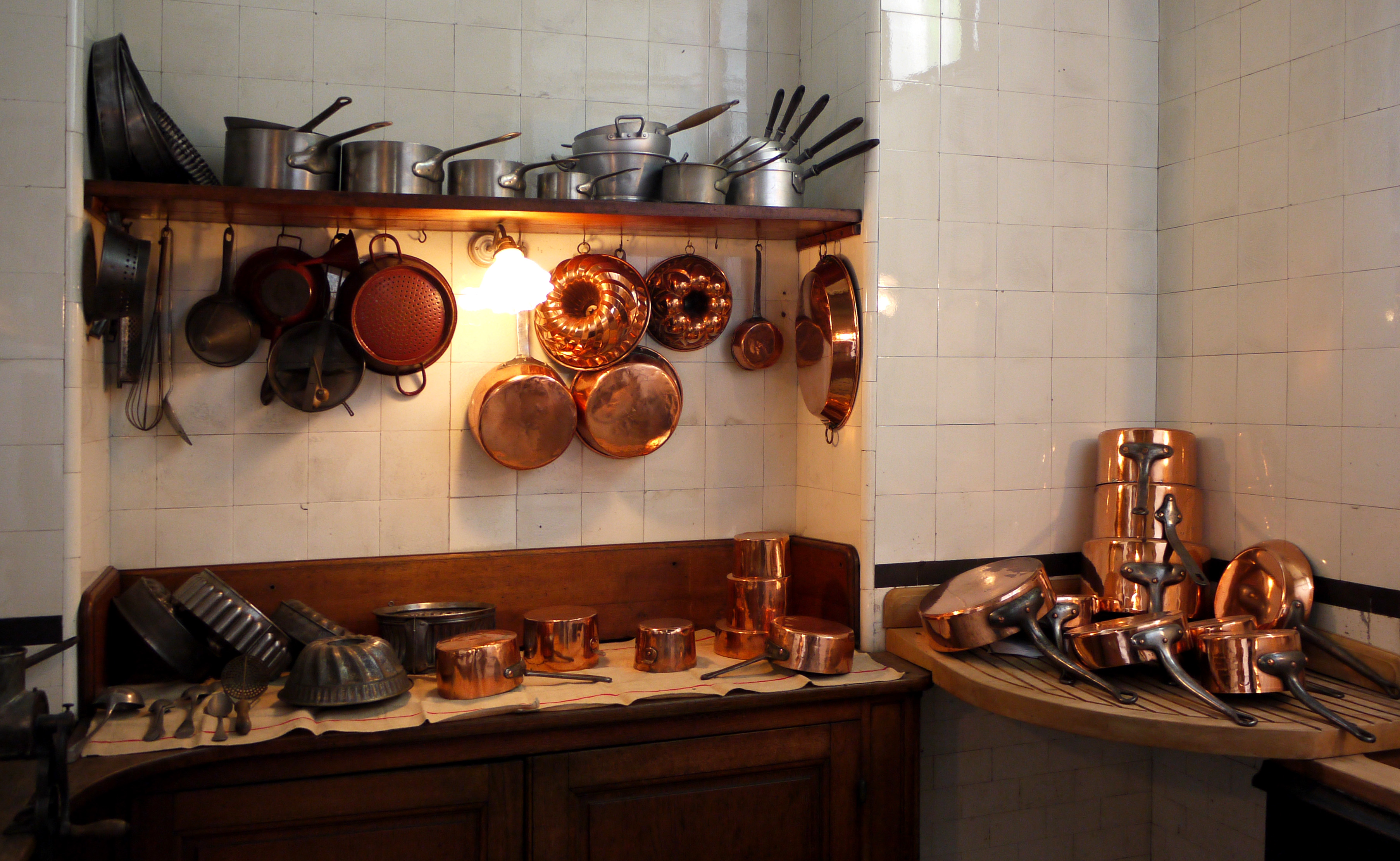|
Dishwashing
Dishwashing, washing the dishes, doing the dishes, or (in Great Britain) washing up, is the process of cleaning cooking utensils, dishes, cutlery and other food-soiled items to promote hygiene and health by preventing foodborne illness. This is either achieved by hand in a sink or tub using dishwashing detergent, or by using a dishwasher, and may take place in a kitchen, utility room, scullery or elsewhere. Implements Dish washing is usually done using an implement for the washer to wield, unless done using an automated dishwasher. Commonly used implements include cloths, sponges, brushes or even steel wool. As fingernails are often more effective than soft implements like cloths at dislodging hard particles, washing simply with the hands is also done and can be effective as well. Dishwashing detergent is also generally used, but bar soap can be used acceptably, as well. Rubber gloves are often worn when washing dishes by people who are sensitive to hot water o ... [...More Info...] [...Related Items...] OR: [Wikipedia] [Google] [Baidu] |
Dishwashing Detergent
Dishwashing liquid (washing-up liquid or fairy liquid in British English), also known as dishwashing soap, dish detergent, or dish soap, is a detergent used in dishwashing. Dishwashing detergent for dishwashers comes in various forms such as cartridges, gels, liquids, packs, powder, and tablets.'''' It is usually a highly-foamy mixture of surfactants with low skin irritation that consumers primarily use for washing glasses, plate (dishware), plates, cutlery, and kitchen utensil, cooking utensils. In addition to its primary use, dishwashing liquid is also used for various informal applications, like creating bubbles, clothes washing, and cleaning off wildlife affected by oil spills. Dishwashing liquid has long existed in various compositions and under different usage conditions. Currently, most dishwashing liquid functions best with hot water. However, there are some special dishwashing liquids designed to work well with cold water or seawater. History Before the invention ... [...More Info...] [...Related Items...] OR: [Wikipedia] [Google] [Baidu] |
Dishwasher
A dishwasher is a machine that is used to clean dishware, cookware, and cutlery automatically. Unlike dishwashing, manual dishwashing, which relies on physical scrubbing to remove soiling, the mechanical dishwasher cleans by spraying hot water, typically between , at the dishes, with lower temperatures of water used for delicate items. A mix of water and dishwasher detergent is pumped to one or more rotating sprayers, cleaning the dishes with the cleaning mixture. The mixture is recirculated to save water and energy. Often there is a pre-rinse, which may or may not include detergent, and the water is then drained. This is followed by the main wash with fresh water and detergent. Once the wash is finished, the water is drained; more hot water enters the tub by means of an electromechanical solenoid valve, and the rinse cycle(s) begin. After the rinse process finishes, the water is drained again and the dishes are dried using one of several drying methods. Typically a rinse aid ... [...More Info...] [...Related Items...] OR: [Wikipedia] [Google] [Baidu] |
Sink
A sink (also known as ''basin'' in the UK) is a bowl-shaped plumbing fixture for washing hands, dishwashing, and other purposes. Sinks have a tap (faucet) that supplies hot and cold water and may include a spray feature to be used for faster rinsing. They also include a drain to remove used water; this drain may itself include a strainer and/or shut-off device and an overflow-prevention device. Sinks may also have an integrated soap dispenser. Many sinks, especially in kitchens, are installed adjacent to or inside a counter. When a sink becomes clogged, a person will often resort to using a chemical drain cleaner or a plunger, though most professional plumbers will remove the clog with a ''drain auger'' (often called a " plumber's snake"). History United States The washstand was a bathroom sink made in the United States in the late 18th century. [...More Info...] [...Related Items...] OR: [Wikipedia] [Google] [Baidu] |
Rubber Gloves
A rubber glove is a glove made out of natural or synthetic rubber. 'Rubber' refers to durable, waterproof, and elastic material made from natural or synthetic latex. Rubber gloves can be unsupported (rubber only) or supported (rubber coating of textile glove). Its primary purpose is the protection of the hands while performing tasks involving chemicals. Rubber gloves can be worn during dishwashing to protect the hands from detergent and allow the use of hotter water. Sometimes caregivers use rubber gloves during the diaper changing process to prevent contact with the child's fecal material/urine. Health professionals use medical gloves rather than rubber gloves when performing surgical operations. Origin In 1894, William Stewart Halsted, the first chief of surgery at Johns Hopkins Hospital, invented rubber gloves for his wife Caroline Hampton as he noticed her hands were affected by the daily surgeries she had performed and to prevent medical staff from developing dermatiti ... [...More Info...] [...Related Items...] OR: [Wikipedia] [Google] [Baidu] |
Scullery (room)
A scullery is a room in a house, traditionally used for washing up dishes and Laundry#History, laundering clothes, or as an overflow kitchen. Tasks performed in the scullery include dishwashing, cleaning dishes and cooking utensils (or storing them), occasional kitchen work, ironing, boiling water for cooking or bathing, and soaking and washing clothes. Sculleries contain hot and cold sinks, sometimes slop sinks, Pipe (fluid conveyance), drain pipes, storage shelves, plate racks, a work table, various Wash copper, coppers for boiling water, tubs, and buckets. The term "scullery" has fallen into disuse in North America, as laundry takes place in a utility room or laundry room. The term continues in use in its original sense in United Kingdom, Britain and Ireland amongst the middle classes, or as an alternative term for kitchen in some regions of Britain, typically Northern Ireland and Scotland, or in designer kitchens. In United States military facilities and most commercial resta ... [...More Info...] [...Related Items...] OR: [Wikipedia] [Google] [Baidu] |
Cooking Utensil
A kitchen utensil is a small hand-held tool used for food preparation. Common kitchen tasks include cutting food items to size, heating food on an open fire or on a stove, baking, grinding, mixing, blending, and measuring; different utensils are made for each task. A general purpose utensil such as a chef's knife may be used for a variety of foods; other kitchen utensils are highly specialized and may be used only in connection with preparation of a particular type of food, such as an egg separator or an apple corer. Some specialized utensils are used when an operation is to be repeated many times, or when the cook has limited dexterity or mobility. The number of utensils in a household kitchen varies with time and the style of cooking. A cooking utensil is a utensil for cooking. Utensils may be categorized by use with terms derived from the word " ware": kitchenware, wares for the kitchen; ovenware and bakeware, kitchen utensils that are for use inside ovens and for baking; ... [...More Info...] [...Related Items...] OR: [Wikipedia] [Google] [Baidu] |
Kitchen
A kitchen is a room (architecture), room or part of a room used for cooking and food preparation in a dwelling or in a commercial establishment. A modern middle-class residential kitchen is typically equipped with a Kitchen stove, stove, a sink with hot and cold running water, a refrigerator, and worktops and kitchen cabinet (furniture), cabinets arranged according to a modular design. Many households have a microwave oven, a dishwasher, and other electric appliances. The main functions of a kitchen are to store, prepare and cook food (and to complete related tasks such as dishwashing). The room or area may also be used for dining (or small meals such as breakfast), entertaining and laundry. The design and construction of kitchens is a huge market all over the world. Commercial kitchens are found in restaurants, cafeterias, hotels, hospitals, educational and workplace facilities, army barracks, and similar establishments. These kitchens are generally larger and equipped with big ... [...More Info...] [...Related Items...] OR: [Wikipedia] [Google] [Baidu] |
Aprons
An apron is a garment worn over other clothing to cover the front of the body to protect from liquids. They have several purposes, most commonly as a functional accessory that protects clothes and skin from stains and marks. However, other types of aprons may be worn as a decoration, for hygienic reasons, as part of a uniform, or as protection from certain dangers such as acid, allergens or excessive heat. It can also be used at work stations to hold extra tools and pieces or protect from dust and unwanted materials. As a top layer that covers the front body, the apron is also worn as a uniform, adornment, ceremonial garb (e.g. Masonic apron) or fashion statement. The word comes from Old French ''napron'', meaning a small piece of cloth. Over time "a napron" became "an apron" through a linguistic process called rebracketing. Styles There are many different apron forms depending on the purpose of the apron. A basic distinction is between waist aprons, which cover the body fr ... [...More Info...] [...Related Items...] OR: [Wikipedia] [Google] [Baidu] |
Parliament Of The United Kingdom
The Parliament of the United Kingdom of Great Britain and Northern Ireland is the supreme legislative body of the United Kingdom, and may also legislate for the Crown Dependencies and the British Overseas Territories. It meets at the Palace of Westminster in London. Parliament possesses legislative supremacy and thereby holds ultimate power over all other political bodies in the United Kingdom and the Overseas Territories. While Parliament is bicameral, it has three parts: the sovereign, the House of Lords, and the House of Commons. The three parts acting together to legislate may be described as the King-in-Parliament. The Crown normally acts on the advice of the prime minister, and the powers of the House of Lords are limited to only delaying legislation. The House of Commons is the elected lower chamber of Parliament, with elections to 650 single-member constituencies held at least every five years under the first-past-the-post system. By constitutional conventi ... [...More Info...] [...Related Items...] OR: [Wikipedia] [Google] [Baidu] |
Steel Wool
Steel wool, also known as iron wool or wire sponge, is a bundle of very fine and flexible sharp-edged steel filaments. It is the most common type of wire wool and is often the type meant when wire wool is mentioned. It was described as a new product in 1896.''Iron Age'', Vol. LVII, p.871, cited by ''Journal of the Iron and Steel Institute'', Volume 50, Issue 2, p.48/ref> It is used as an abrasive in finishing and repair work for polishing wood or metal objects, cleaning household cookware, cleaning windows, and sanding surfaces. Steel wool is made from low-carbon steel in a process similar to broach (metalworking), broaching, where a heavy steel wire is pulled through a toothed die that removes thin, sharp, wire shavings. Uses Steel wool is commonly used by woodworkers, metal craftsmen, and jewelers to clean and smooth working surfaces and give them shine. However, when used on oak, remaining traces of iron may react with tannins in the wood to produce blue or black iron stain ... [...More Info...] [...Related Items...] OR: [Wikipedia] [Google] [Baidu] |







